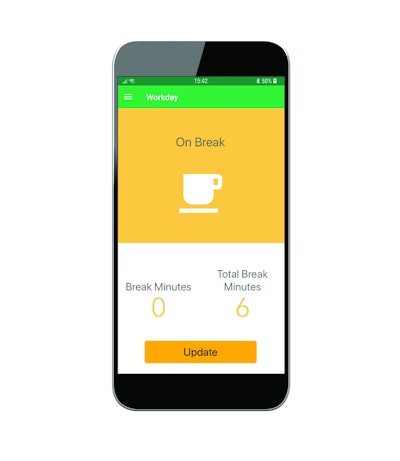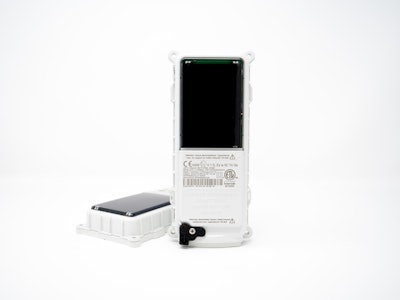 Landscape companies use NexTraq to stay in touch with their crews throughout the day.
Landscape companies use NexTraq to stay in touch with their crews throughout the day.Photo: NexTraq
If you’ve been around in the landscaping industry for any period of time, you’ve probably come across the buzzword of telematics when it comes to managing your fleets.
But have you ever wondered where the word comes from or if your company could benefit from applying telematics to your fleet? Below is a brief history of telematics, the benefits of adding a telematics system and an overview of NexTraq.
The history
Telematics is the combination of the internet, GPS and machine-to-machine communication (M2M).
 At the office, in the field or out of town, managers can stay on top of what’s going on with the NexTraq View mobile app.
At the office, in the field or out of town, managers can stay on top of what’s going on with the NexTraq View mobile app.Photo: NexTraq
During the 1960s, the U.S. Department of Defense used GPS technologies to track its assets.
The word ‘telematics’ is a translation of the French word ‘télématique’ which was coined by Simon Nora and Alain Minc in a 1978 report to the French government about the computerization of society.
As time passed, GPS systems began to reach the consumer market after GPS was made available for public use in 1983. In 1996, it was decided to make GPS an international utility that would be provided on a continuous worldwide basis, free of direct user fees.
By the mid-2000s, the market was flooded with GPS-based vehicle navigation systems. Technology advancements now allow for precise tracking of GPS data and other parameters for real-time reporting.
The benefits
One thing that can be confused about telematics is believing it is just a fancy term for GPS tracking. While GPS can provide data about your location, telematics is able to analyze and use that information and communicate it to others who are not in the vehicle.
 It’s easy for landscape crews to clock in and clock out from the job site with the NexTraq Connect mobile app.
It’s easy for landscape crews to clock in and clock out from the job site with the NexTraq Connect mobile app.Photo: NexTraq
“I would say any company who has the need to identify vehicles, manage their productivity and visibility of vehicles, has concerns in regards to ensuring that their vehicles are being properly utilized and has the concern over maximizing operational efficiencies and driver safety should absolutely take advantage of a GPS fleet telematics offer,” says Todd Hanna, vice president of sales for NexTraq.
The two main benefits that come from using telematics are improving your company’s productivity and safety.
When your crews are out and about, without telematics there is no way to track your crews and determine what areas you can improve on, such as routing and dispatching.
“It also helps you manage the mobility of your workforce,” Hanna says. “If you don’t have a way to accurately manage your employees’ ability to clock in and clock out if they’re working remotely. If they don’t come to a standardized domiciled location on a daily basis, it helps people really manage start stop times, break times, on top of the dispatching and overall visibility and productivity.”
Another aspect of how telematics helps with productivity is how it can provide predictive maintenance reminders and diagnostics for optimizing fuel usage.
As for safety, telematics systems can determine when risky driving behaviors are occurring so you can work with employees to eliminate bad driving habits and they can also help locate stolen vehicles.
NexTraq features
One telematics option is NexTraq, which is a Michelin group company that is part of Michelin’s Global Service and Solutions business line. NexTraq has been in business since 2000.
“We’ve been in the industry a little bit longer than the vast majority of our competitors,” Hanna says. “The things that separate us is the combination of vehicle tracking, dispatching and maintenance. We have a lot of services that are encompassed in one application. The other thing that sets us apart is the ease of use.”
Hanna explains that with NexTraq it is easy to understand and interpret the collected data without having to run through the analytics side of it.
 Solar-powered satellite asset trackers from NexTraq are designed for up to 10 years of maintenance-free service.
Solar-powered satellite asset trackers from NexTraq are designed for up to 10 years of maintenance-free service.Photo: NexTraq
The NexTraq system works by having a piece of hardware installed into the onboard computer on the vehicle or hardwired onto the engine component.
“We can track moving and non-moving assets, roughly 60 percent of our subscriber base tracks moving vehicles,” Hanna says. “We can track non-moving vehicle assets just as easily as we can moving vehicle assets. A good example in the landscaping industry would be mowers or large pieces of equipment that may not necessarily run on the road, but they get trailered around or left at a certain location.”
NexTraq has a monthly subscriber base and the pricing varies depending on the functionality the user wants access to. The base level subscription provides access to NexTraq View and NexTraq Connect. View is for the managers allowing them to see things holistically, while Connect is for the drivers, which lets them to report problems and communicate with other drivers.
NexTraq Dispatch is an added function that allows users to assign jobs. NexTraq Verify is a new addition that is an upgrade to Dispatch, which allows employees to capture photos and customer signatures. NexTraq Driver Awareness is an add-on that alerts drivers when they are driving too aggressively.
“The biggest response we get from our customers is it’s a cost-effective, easy to use solution that allows them to manage all the aspects of their fleet and allows them to grow efficiently,” Hanna says. “The landscaping industry is really our sweet spot when it comes to hitting a lot of the needs that they have.”
Features like geofencing will alert the owners to when a vehicle or piece of equipment leaves its set radius and owners can also get texts or emails when their vehicles are being operated unsafely.
“It allows the people who are running the operations to be able to have the comfort and security that they can keep an eye on their operation without having to physically be there,” Hanna says.










